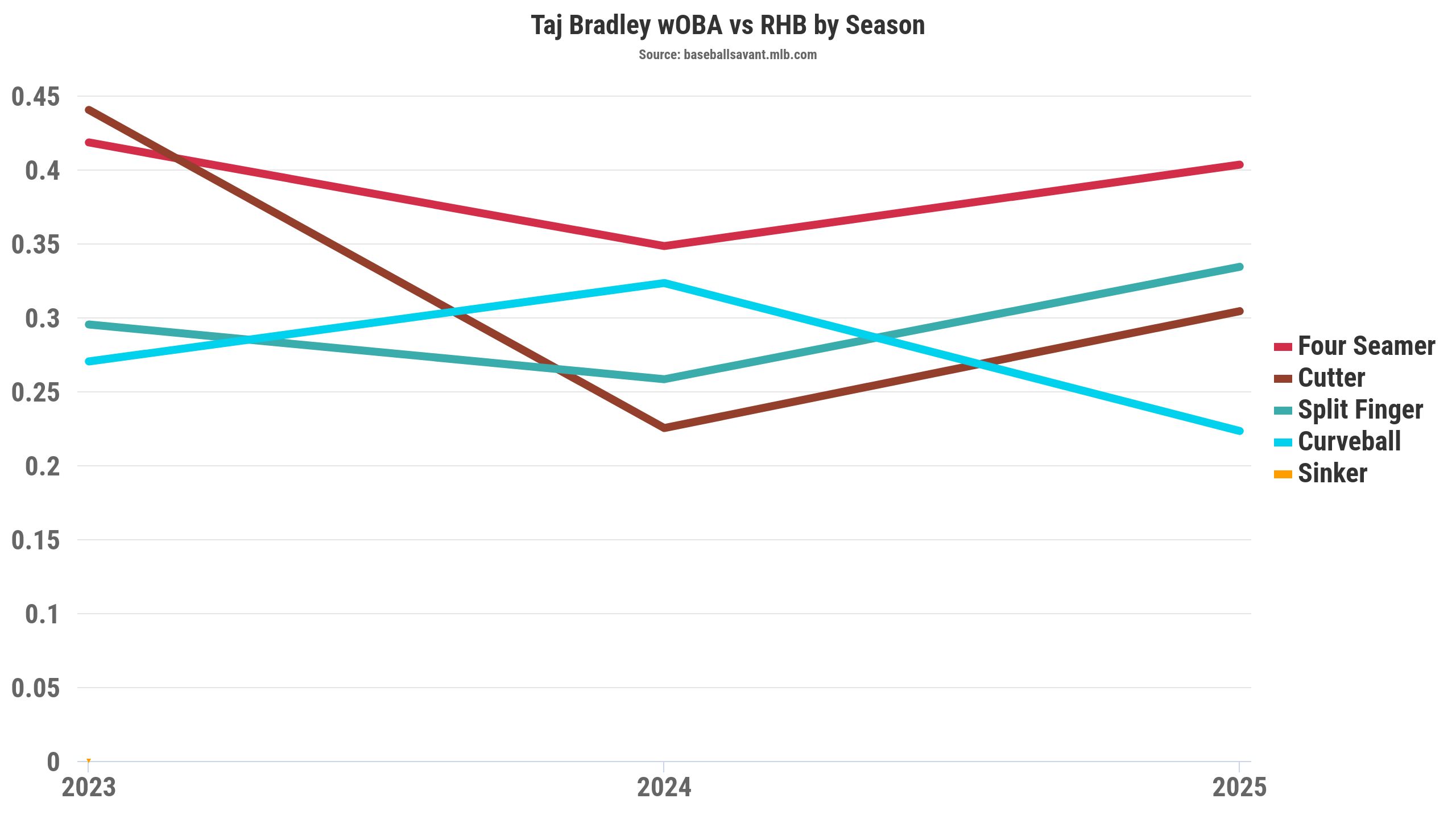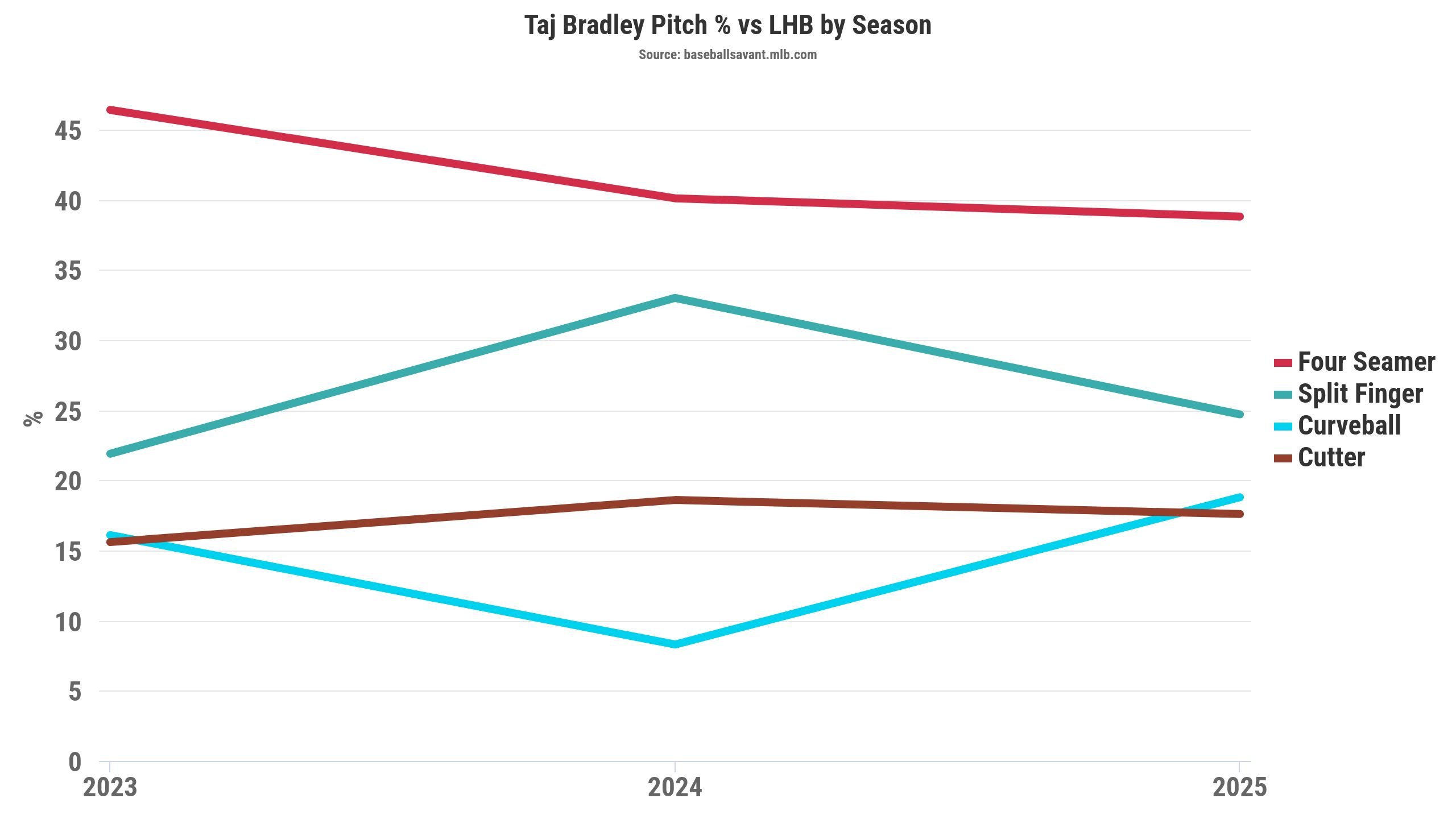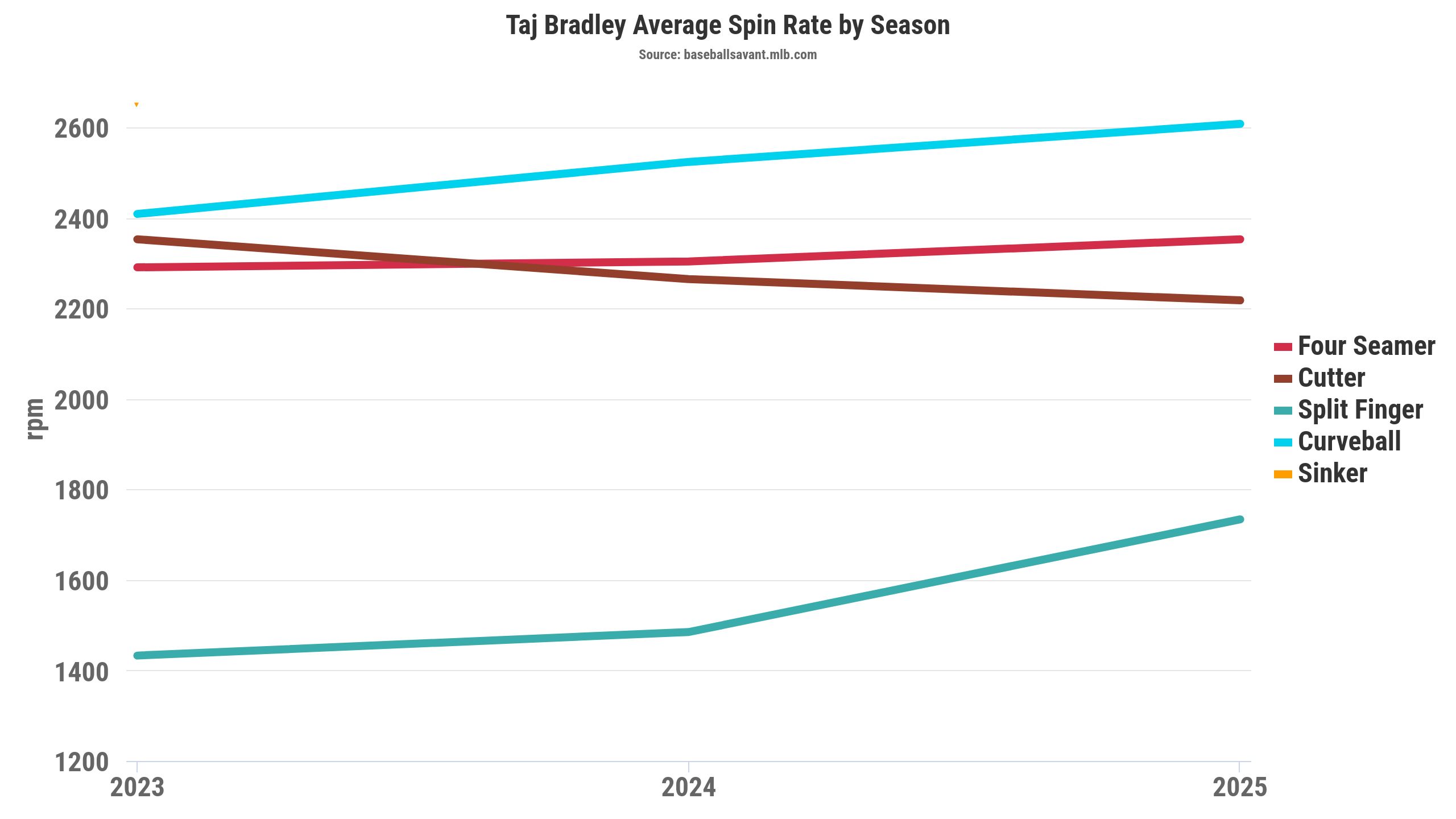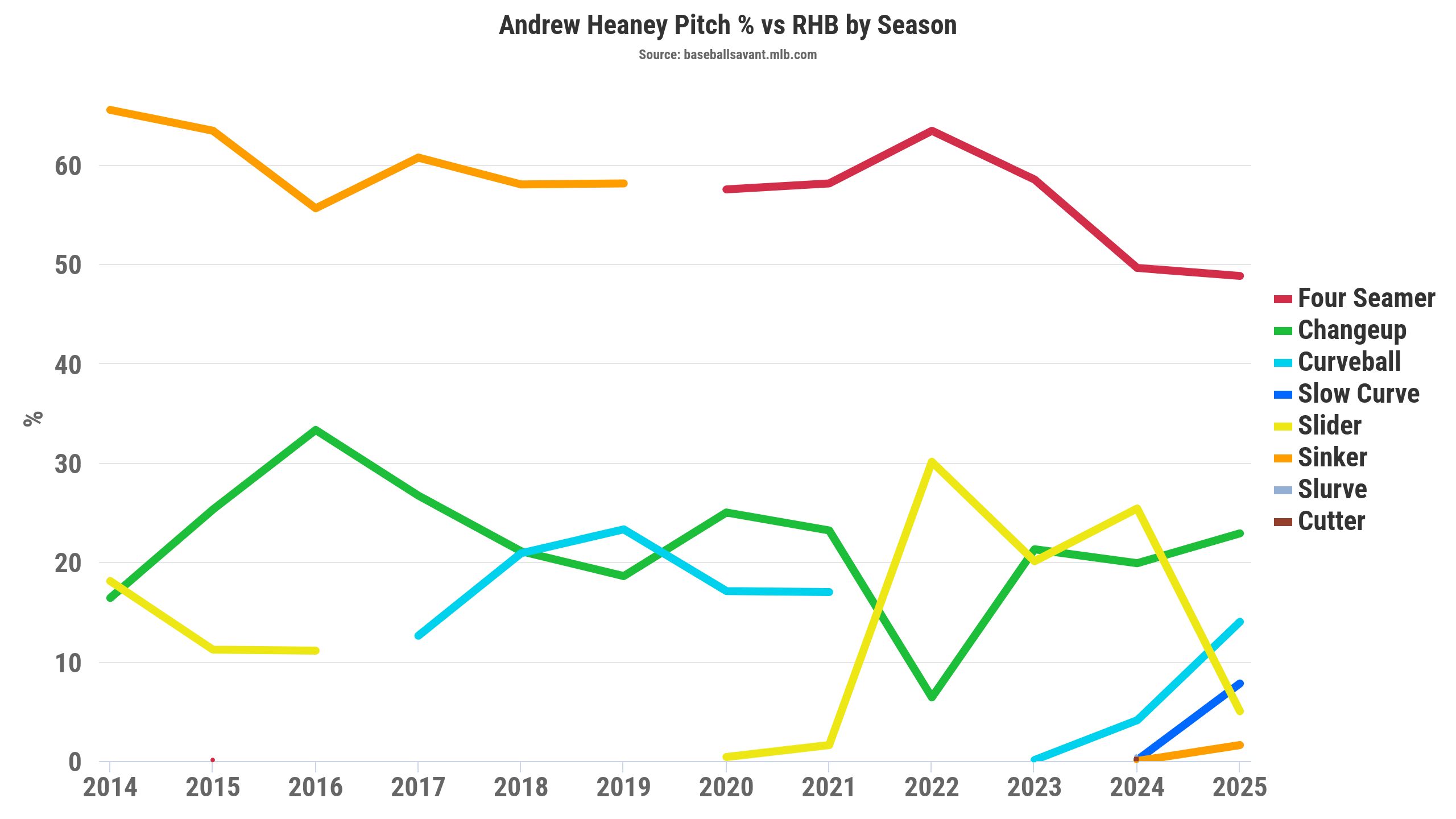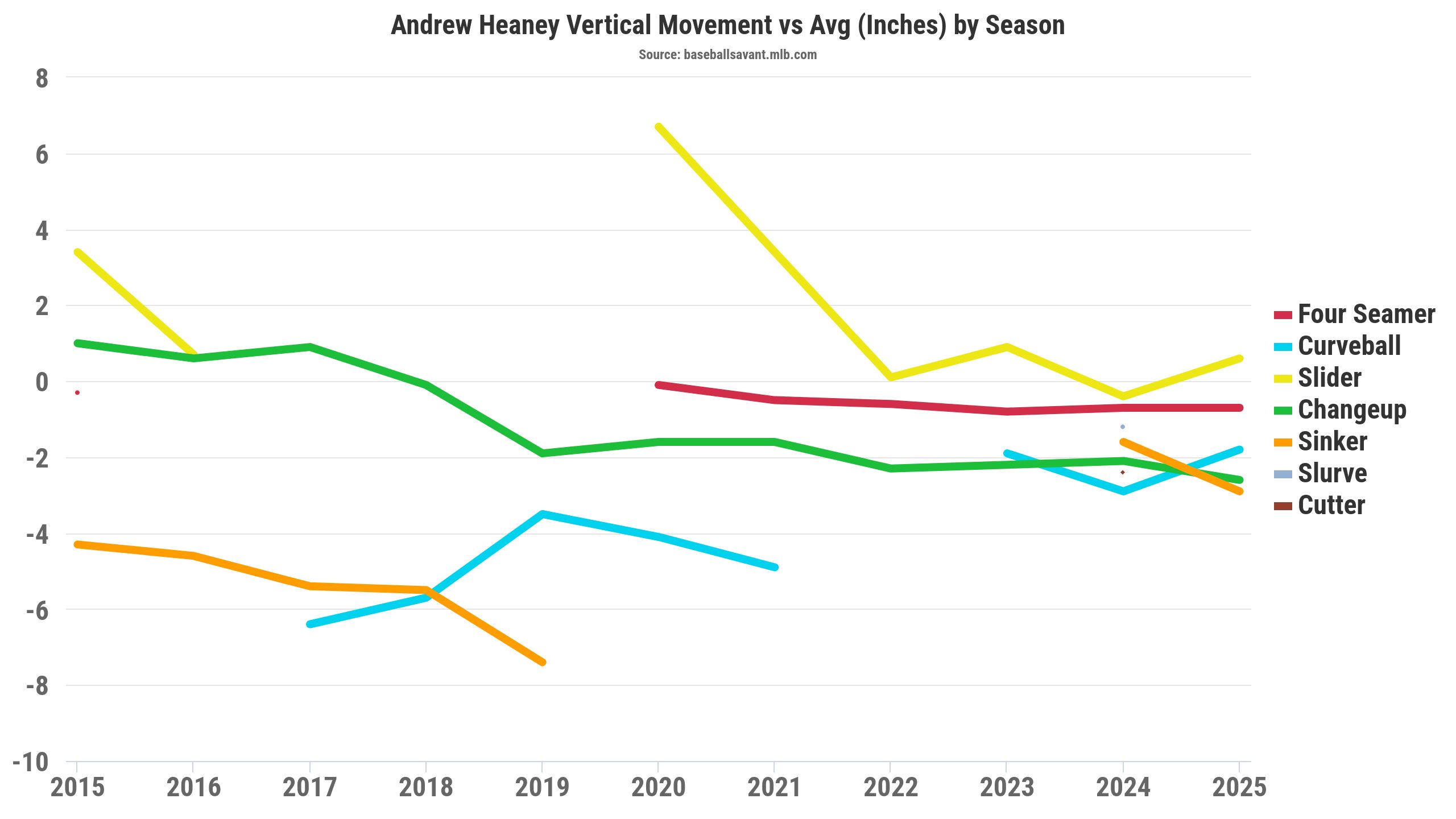Corbin Young examines several fantasy baseball pitcher risers and sleepers displaying changes in their pitch mix, movement, and velocity heading into Week 5 (2025).
Welcome back, RotoBallers, to my weekly "Starting Pitcher Arsenal Changes" article series for Week 5 of the 2025 fantasy baseball season. Hopefully, very few of you got the Easton Lucas treatment, where the underlying data looked interesting, but he was rocked in his two-start matchups. Today's article will discuss a few starting pitchers who made actionable adjustments, like a release point change or a new pitch. For those new to this column, we cover a few starting pitchers and their arsenal changes via pitch mix, velocity, and movement each week.
Since it's early, we're looking for new pitches, velocity, and movement changes. With these pitchers having a limited sample of starts, we can compare their previous outings and the previous season. When we find significant release point shifts, it can potentially impact their movement profiles in 2025.
Pitchers can make notable changes in smaller samples, so let's see if we can find something with these starting pitchers. Statcast introduced pitch percentage splits by left- or right-handed batters, which adds a nice layer to compare quickly to past seasons. Let's look through my process of examining starting pitchers and their arsenals. Reach out to me on X if you have a pitcher and have questions about it. This is the third article of this series for the 2025 season. Thank you for reading!
Be sure to check all of our fantasy baseball lineup tools and resources:- Fantasy baseball trade analyzer
- BvP matchups data (Batter vs. Pitcher)
- PvB matchups data (Pitcher vs. Batter)
- Who should I start? Fantasy baseball comparisons
- Daily MLB starting lineups
- Fantasy baseball closer depth charts
- Fantasy Baseball live scoreboard
- Fantasy baseball injury reports
Taj Bradley Should Lower His Four-Seam Usage
Bradley teased us with his 12-13 percent swinging strike rate. The Rays tend to have pitchers throw four-seamers up in the zone, which we like. That's especially true when Bradley's four-seam has above-average induced vertical break (IVB) of 18-19 inches.
Bradley lacks extension as he throws from a higher arm angle (53 degrees). That can cause his four-seamer to have a higher vertical approach angle of -4.5 to -4.8 degrees, meaning it's a steeper fastball. With four-seamers, especially related to IVB, we want flatter fastballs, making it harder to square up and do damage. A quick fix, but likely unrealistic, would be to lower Bradley's arm angle to generate more extension.
So, why does that matter? Opposing hitters have been destroying Bradley's four-seamer, with a .405 wOBA (.423 xwOBA) versus right-handed hitters and a .478 wOBA (.362 xwOBA) against lefties. Bradley's cutter (.225 wOBA) and splitter (.258 wOBA) were somewhat effective against righties in 2024. However, the outcomes regressed, with the splitter giving us some hope based on the .268 xwOBA (.335 wOBA) versus right-handed hitters.
We'll cover the splitter more later, but we want him to use the splitter, curveball, and cutter more often against left-handed hitters. They've been something he uses more versus opposite-handed hitters, especially the curveball. That aligns with our hopes of Bradley ditching the four-seamer more and using his better pitches more often.
The results and whiffs against left-handed hitters support the lowering of the four-seamer, with the early positive sample via the splitter (.197 wOBA), curveball (.000 wOBA), and cutter (.223 wOBA).
Bradley's Cutter and Curveball Are More Effective, But Why?
Bradley's cutter movement profiles haven't shifted much, but he throws a harder curveball (+1.6 mph). That led to his curveball losing over five inches of downward movement and two inches of sweep. Though Bradley's curveball doesn't elicit many whiffs (8.3 percent swinging strike rate), it results in weak contact.
With Bradley's cutter, the locations have changed, though it's an early sample. Bradley was locating the cutter down and away from right-handed hitters, leading to more whiffs (14.9 percent SwK). However, Bradley has been locating his cutter more traditionally high and inside to right-handed hitters, as seen in the visual below.
He traded whiffs (11.8 percent SwK) for more weak contact via the cutter, with the location change being notable and significant. It should intrigue us more with Bradley after seeing those cutter locations and curveball movement changes.
Bradley's Splitter is Different
Like Bradley's curveball, his splitter looks different. It lost two inches of downward movement and gained two inches of arm-side fade. The splitter also has the highest spin rate (1,750 rpm) of his career, with it hovering at 1,495 (2023) and 1,478 (2022) over the past two seasons.
For context, the league average spin rates on splitters have been 1,300 to 1,330 rpm over the past two seasons. It looks more actionable than fluky because the whiffs were maintained (15.1 percent SwK), with improved weak contact, similar to 2023.
With the spin rate increase, Bradley's splitter stayed in the middle of the zone more often instead of being more down and away to left-handed hitters. Bradley's splitter's induced movement profile has been different than the league average, possibly making it harder to square up.
Splitters can be hard to command. There's a chance the locations have been more erratic as he struggles to command them in 2025. One would hypothesize that the splitter with a lower spin rate, being more knuckleball-like, might be more unpredictable.
Summary
We initially expected to find very few optimistic arsenal changes. However, Bradley's cutter and curveball have improved, with reasons to support the outcomes. When pitchers have ineffective fastballs, we want them to have multiple secondary offerings to lean on. That's the case with Bradley, and we would recommend buying low, though we know it can be a roller-coaster ride.
Bradley threw a quality start against the Diamondbacks on Wednesday, but the whiffs weren't there, with a 5.8 percent swinging strike rate. The spin rate on Bradley's curveball dropped nearly 100 rpm, and he lost two inches of downward movement in Wednesday's outing. He continued throwing the splitter more in the heart of the zone on Wednesday, like the season-long data, which worries us.
Andrew Heaney Throwing More Curveballs (Again)
Let's examine Heaney, who has been throwing more curveballs, again, before shifting to four-seamers and sliders over the previous few seasons. Against right-handed hitters, Heaney threw more curves (14 percent) and slow ones (7.8 percent), as the third- and fourth-most-used pitches.
In recent seasons, Heaney threw changeups and sliders more often versus righties, so this seems like an actionable change. The slow curve has been sneaky good, allowing a .000 wOBA (.024 xwOBA). However, Heaney's curveball should regress against his favor, evidenced by the .260 wOBA and .382 xwOBA.
The same trend occurred against left-handed hitters since he used to throw sliders 34.4 percent in 2024, 43.5 percent in 2023, and 41.1 percent in 2022. Heaney threw four-seamers and sliders 91-98 percent of the time to lefties over the past three seasons. He has been mixing in more sinkers and curveballs versus same-handed hitters.
Heaney Lowered His Arm Angle
Speaking of Heaney's sinkers, he has been throwing them slower by nearly 3 mph in 2025 versus 2024. Heaney's arm angle dropped to a career-low 25 degrees with the lower velocity. We'll note that data only comes from when Baseball Savant tracked that metric (2017). That theoretically should lead to more horizontal movement.
Unsurprisingly, Heaney's sinker generates the most arm-side movement of his career, turning it into an above-average profile. If Heaney's sinker has tons of horizontal movement, we would expect him to throw it more on the inside of the plate to same-handed hitters, leading to weak contact.
The tricky part of examining Heaney's sinker involves him shifting more toward four-seamers starting in 2020. Meanwhile, he threw a sinker nine times in 2024, so we shouldn't compare it to the recent season. Regardless, we'll want to pay attention to Heaney's sinker locations low and inside to lefties, leading to career-best outcomes (.160 wOBA, .245 xwOBA).
Summary
Sometimes we overlook sinkers as a somewhat less exciting pitch in the age of whiffs, stuff, and velocity. That's partly my personal bias since we're drawn toward movement, IVB, release points, and swinging strikes.
Heaney's curveball and sinker might intrigue us, but they will lead to fewer whiffs, evidenced by his career-low 9 percent swinging strike rate in 2025. Contrarily, Heaney could trade whiffs for more pitch-per-start efficiency, meaning going deeper into games. Ride the wave with Heaney, especially with these arsenal changes.
It's probably some classification error, but Heaney threw an unknown pitch 38 percent of the time on Wednesday. Or maybe it's an error because it shows him eliciting 24 whiffs against the Angels. Heaney had a dominant outing with six scoreless innings and nine strikeouts versus the Angels. He has reworked his arsenal and arm angle in 2025, so we should buy into these changes as a deep league streamer.
Griffin Canning is Backing Off His Four-Seam
We want pitchers to throw their best pitches more, but it's easier said than done. Canning's slider has been his best pitch for whiffs with a 19.4 percent swinging strike rate in 2025, similar to his career average (18.3 percent). Most notably, Canning has backed off his four-seam usage against right-handed hitters, trading the heater for more sliders (44.7 percent).
We've seen Canning throw tons of sliders versus righties, but he's throwing them at a career-high rate. The results have been decent, with a .282 wOBA (.282 xwOBA) against right-handed hitters in 2025, similar to 2024 (.341 wOBA, .312 xwOBA). Canning's slider typically possessed near-elite downward movement, but it added nearly four inches of drop.
The slider's velocity and spin rates remained similar to previous seasons. Our initial guesses would be the release point or grip changes. Canning's horizontal release point moved nearly five inches (4.9) closer to this midline while maintaining the vertical release. We'll note his slider release point shifted closer to 2023, with two more inches of drop in 2025.
Theoretically, Canning's horizontal release point moving closer to his midline would impact the movement profiles. Baseball Savant provides the induced movement profiles by pitch, and we can see how Canning's slider should drop more and generate more downward movement than the average pitch.
Canning throws his slider in the zone 49-50 percent of the time with a ridiculous 46.9 percent chase rate. For context, the slider league average for zone rate was 45.1 percent, with a 24.5 percent chase rate. That hints at Canning's slider command and elite vertical movement profile as a gyro slider for whiffs.
Summary
If you were into Canning before the season or in previous years, this should make you hyped for sustainability in 2025. Canning fits the prototypical streaming pitcher with strikeout upside since he runs a higher WHIP (1.38), yet flashes above-average skills (12.4 percent swinging strike rate and 117 Base Performance Index).
We like the approach for Canning, throwing fewer four-seamers and more sliders. That's especially notable with Canning's slider looking better while throwing more of it. A wild card in Canning's arsenal is the changeup, which added three inches of downward movement, helping to generate whiffs (12.5 percent SwK) and limiting the damage (.315 wOBA, .324 xwOBA) versus lefties.
Download Our Free News & Alerts Mobile App
Like what you see? Download our updated fantasy baseball app for iPhone and Android with 24x7 player news, injury alerts, sleepers, prospects & more. All free!






 RADIO
RADIO









